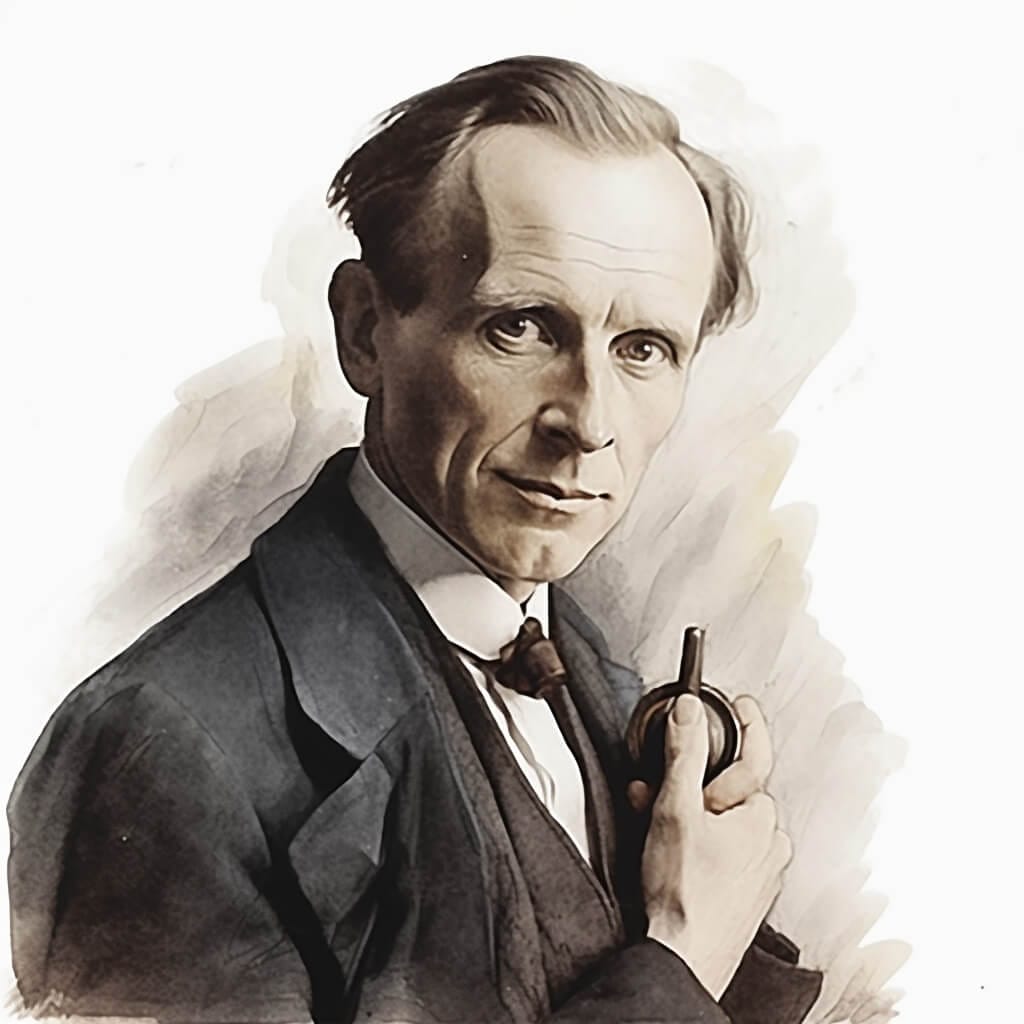A. A. Milne was a well-loved children’s author who is best known for his Winnie-the-Pooh books and related poems. Before he began writing his famed children’s stories, he had already established himself as a screenwriter, poet, playwright, and novelist. Milne’s work became known for exploring themes such as childhood, nostalgia, and the natural world. However, despite his success as a children’s writer, it is said that he somewhat resented the fact that he had been pigeonholed purely as a children’s author. In reality, he had the desire to be recognized as a literary heavyweight of all ages.
Life Facts
- Alan Alexander Milne, better known as A. A. Milne, was born in Kilburn, London, England, in January 1882.
- In 1927 he published ‘Now We Are Six.’
- He wrote plays, screenplays, detective stories, and of course, children’s literature and poetry.
- In 1952 he had a stroke and later brain surgery, which forced him to retire permanently to his farm.
- A. A. Milne died in January 1956 a the age of 74.
Interesting Facts
- A. A. Milne worked as the editor for Granta, a student-run magazine, while at Trinity College.
- Milne was injured during the Battle of the Somme in July.
- He is remembered for his Winnie-the-Pooh books.
- Milne wrote for the British film industry.
- Milne was Captain of the British Home Guard in Hatfield & Forest Row.
Famous Poems
- ‘If I Were King’ contains a child’s musings on what he’d do if he were king. Since this is a youthful poem, his desires are amusing and outlandish. He spends a lot of his time thinking about what it would be like to be king and all the “lovely things to do.” He would get rid of all the adult rules that control his life and keep wild animals. Any young reader should be able to connect with the youthful speaker’s dreams.
- ‘Solitude’ is a simple poem within the Winnie-the-Pooh cannon. In it, the speaker discusses Christopher Robin’s “house” and his moments of solitude. His “house” is out in the woods, where he can go to get away from everyone else. He can find peace and quiet there.
- ‘Now We Are Six’ is one of the best of A. A. Milne’s poems. It is told from the perspective of a young child who looks back on the brief years of their life. He remembers years one through five and how he has slowly gotten better as he’s aged. The child believes that once he turns six that he’s going to want to stay that age forever, never getting any older.
- ‘Sneezles’ is a funny two-stanza poem that features Christopher Robin. In the poem, the speaker describes a complex, nonsense illness that Christopher contracts. His parents put him to bed, they call doctors, and in the end, it turns out that he was just thinking of a way to “amuse” his parents.
- ‘The Friend’ is a light-hearted poem in which the speaker discusses his own self-conscious perceptive. In the text, the poet creates a number of relatable lines that everyone should be able to relate to. The idea that others think that you’re “silly” or dumb. Pooh features in the second half of the poem. He doesn’t know the answer to a question, but the speaker assures him that it doesn’t matter either way.
Early Life
Alan Alexander Milne, better known as A. A. Milne, was born in Kilburn, London, England, in January 1882. His father was John Vine Milne, from Jamaica, and Sarah Marie Milne. Milne’s father worked as the headmaster at the same private school, Henley House School, where Milne grew up. While there, he was instructed by teachers such as H. G. Wells.
Education
His early education continued at Westminster School and Trinity College, Cambridge. He studied on a mathematics scholarship and later graduated with a B.A. in Mathematics in 1903. While enrolled at Trinity, he worked as the editor for Granta, a student magazine. He also submitted articles to the publication using the initials AKM. Milne moved to London to pursue a career as a freelance writer. He continued to submit articles to various publications, including his essays and humorous poetry. This early work was noticed by Punch magazine, the leading humor issue. They later hired Milne as a contributor and assistant editor in 1906.
Over the following years, he published eighteen plays and three novels. One of the better known of this period is The Red House Mystery. In 1913 Milne married Dorothy ‘Daphne’ de Sélincourt. Their son, Christopher Robin, was born seven years later. After his birth, Milne wrote a collection of children’s poems titled ‘When We Were Very Young.’ They were illustrated by one of his colleagues, E. H. Shepard.
World War I
During World War I, Milne served as an officer in the British Army in the Royal Warwickshire Regiment. During his military service, he suffered from an undetermined illness and was later reassigned to the Royal Corps of Signals, where he served as a signaling officer. Milne was commissioned as a second lieutenant in France in February of 1915 and was injured during the Battle of the Somme in July of the next year. When he recovered, he was recruited into Military Intelligence and began writing for MI7. This posting lasted for two years before he was discharged in 1919.
After leaving the army, he made a home for himself in Chelsea. He later bought a country home in Hartfield, East Sussex. A few years after the war ended, he penned the book Peace with Honour. The piece was a vehement denunciation of war, a position he retreated from by the time he published War with Honour in 1940. A few years after the birth of his son, Milne wrote a volume of short stories aimed at a young audience, A Gallery of Children. It was published in 1925 and is now considered to be part of the Winnie-the-Pooh books for which he is best known.
It was also around this period that he wrote for the British film industry. There were four stories he completed that were later filmed for the Minerva Films company. These included Five Pound Reward and Bookworms.
Winne-the-Pooh and Writing Career
It is for his two Winnie-the-Pooh children’s books that Milne is best known today. They contain stories about a boy named Christopher Robin and an array of animal toys such as; Pooh, Piglet, Tigger, Kanga, Roo, Rabbit, Owl, and Eeyore. A number of elements of the stories derive from Milne’s own world. The “Hundred Acres Wood” comes from the “Five Hundred Acre Wood” in East Sussex, and the child, Christopher Robin, is named after Milne’s own son. The inspiration for Pooh’s character comes from his child’s own stuffed animal, and the name ‘Winnie’ came from a military mascot, the bear Winnipeg. These stuffed animals are now on display at the New York Public Library.
The character that would later be known as Pooh first appeared in the poem, ‘Teddy Bear,’ published in February of 1924 in Punch. It was republished in the collection ‘When We Were Very Young.’ By name, Pooh appeared for the first time in the London Evening News in 1925. In 1927, Milne published ‘Now We Are Six.’ It was a collection of nursery rhymes and a part of a set of four books which were illustrated by E. H. Shepard.
The books were incredibly successful, a fact that came to annoy the writer. It had been his goal to write in whatever style he chose, but with an audience at hand, that became more difficult. Throughout his life, he wrote plays, screenplays, detective stories, and of course, children’s literature and poetry.
Later Life
In the 1930s, Milne adapted the novel The Wind in the Willows, by Kenneth Grahame, for the stage. He later wrote his autobiography. It was performed as Toad of Toad Hall. Later in life, the relationship between Milne and his wife soon became strained. The real Christopher Robin felt as if his childhood had been exploited, and he deeply disliked the public attention his family received.
In the 1940s, during the years of World War II, Milne was Captain of the British Home Guard in Hatfield & Forest Row.
Death
In 1952 he had a stroke and later brain surgery, which forced him to retire permanently to his farm. A. A. Milne died in January 1956 at 74.
Influence from other Poets
A. A. Milne was notably influenced by writers such as likely influenced by writers like Lewis Carrol and Edward Lear. His son’s influence, who, as an inspiration for Christopher Robin, was also very important in his life.
FAQs
A.A. Milne’s fortune, which was mostly accrued from Winnie-the-Pooh, was left to multiple parties. These were; his family, Westminster School, the Garrick Club, and the Royal Literary Fund. However, later on, the wife of Milne did sell off her rights, with these falling into the hands of Disney years later.
Alan Alexander Milne was famous for his poems, stories, and other works during the 20th century. His crowning glory was, without a doubt, the creation of Winnie-the-Pooh, which made him very financially successful and has become a children’s classic.
Interestingly, despite its incredible success, A. A. Milne started to resent the fame that came from his creation Winnie-the-Pooh. Not only did he become pigeonholed as a children’s writer, despite a desire to write more serious literature, but his son Christopher Robin was also subject to more attention than Milne first anticipated.
A. A. Milne had a very distinctive style of writing that translated into his poems and his novels. He is known for his witty, humourous style that utilizes wordplay excellently. His style worked well for children’s books and poems.
A. A. Milne was responsible for writing four individual works that were centered around Winnie-the-Pooh. These titles were; ‘When We Were Very Young,’ published in 1924; Winnie-the-Pooh in 1926; ‘Now We Are Six,‘ published in 1927; and The House at Pooh Corner in 1928.


